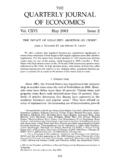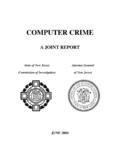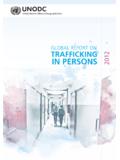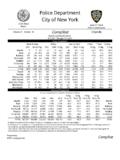Transcription of Understanding Why Crime Fell in the 1990s: Four …
1 Understanding Why Crime fell in the1990s: Four Factors that Explain theDecline and Six that Do NotSteven D. LevittCrime fell sharply in the United States in the 1990s, in all categories ofcrime and all parts of the nation. Homicide rates plunged 43 percent fromthe peak in 1991 to 2001, reaching the lowest levels in 35 years. TheFederal Bureau of Investigation s (FBI) violent and property Crime indexes fell 34and 29 percent, respectively, over that same period. These declines occurredessentially without warning: leading experts were predicting an explosion in crimein the early and mid-1990s, precisely the point when Crime rates began to experts failed to anticipate the decline, there has been no shortageof hypotheses to explain the drop in Crime after the fact. Table 1 presents a tally ofa Lexis-Nexis search of the most frequently cited reasons for the Crime decline inarticles in major newspapers over the period 1991 2001.
2 The single most frequentexplanation given is the innovative policing strategies put into place. The crimedecline is also frequently attributed to increased imprisonment, changes in themarket for crack cocaine, the aging of the population, tougher gun control laws,the strong economy and increases in the number of this paper, I attempt to sort out why Crime declined in the 1990s. I beginwith a review of the facts. I then analyze the leading explanations for why Crime fell ,looking at possible determinants that changed in some substantial way in the of the supposed explanations listed in Table 1 actually played little direct rolein the Crime decline, including the strong economy of the 1990s, changing demo-graphics, better policing strategies, gun control laws, concealed weapons laws andincreased use of the death penalty. Four factors, however, can account for virtuallyySteven D.
3 Levitt is the Alvin H. Baum Professor of Economics, University of Chicago, andResearch Fellow, American Bar Foundation, both in Chicago, Illinois. This article was writtenwhile the author was a fellow during the 2002 2003 academic year at Center for AdvancedStudy in the Behavioral Sciences, Stanford University, Stanford, of Economic Perspectives Volume 18, Number 1 Winter 2004 Pages 163 190all of the observed decline in Crime : increases in the number of police, the risingprison population, the waning crack epidemic and the legalization of , I conclude that the decline in Crime does not really pose a puzzle, but rather,is readily explained by the available theories. The real puzzle that stands unan-swered, I argue, is why Crime rates did not start falling earlier. In the nal section,I offer some tentative observations about what Crime trends might be expected inthe next ning Features of the Decline in Crime in the 1990sSeveral different aspects of the decline in Crime are particularly noteworthy: itssize, breadth and persistence across categories of Crime ; its universality acrossgeographic and demographic groups; and its unexpectedness.
4 I consider thesecharacteristics in Magnitude of the DeclineThe most remarkable feature of the Crime decline in the United States was itssheer magnitude. Figure 1 presents time series data for homicides from 1950 to1 Reyes (2002) offers an additional intriguing explanation for the decline in Crime : the reduction inlevels of lead in the blood due to the elimination of leaded gasoline and lead-based paints. Because ofthe highly speculative nature of the Reyes conjecture at the present time, I do not discuss this hypothesisat greater length, although it is clearly an area worthy of continued future Explanations for the Decline in Crime in the1990s, Ranked by Frequency of MentionExplanationNumber of mentionsInnovative policing strategies52 Increased reliance on prisons47 Changes in crack/other drug markets33 Aging of the population32 Tougher gun control laws32 Strong economy28 Increased number of police26 All other explanations34 Notes:Based on a Lexis-Nexis search of articles written about thenational decline in Crime in leading newspapers over the period1991 2001.
5 Newspapers included in the tabulation are theNew YorkTimes, Washington Post, USA Today, Houston Chronicle, San FranciscoChronicle, Chicago Sun Times, Boston Globe, Atlanta Journal Constitution,Minneapolis Star Tribune and San Diego are theten largest circulation newspapers that are included in Journal of Economic Perspectives2001. Homicide is the most accurately measured and most serious Crime and thusprovides a useful benchmark. Homicide rates were relatively steady at about 4 5per 100,000 population from 1950 through the mid-1960s, at which point theystarted rising to a peak of per 100,000 population in 1980. From 1980 to 1991,the homicide rate uctuated between 8 10 per 100,000 population. After that, thehomicide trend began a large, steady decline. Between 1991 and 2000, homiciderates per capita fell from to per 100,000, a drop of 44 percent.
6 Since thattime, homicide rates have been same pattern observed for homicide is present for every major crimecategory and in both of the commonly used measures of Crime in the United States:theFBI s Uniform Crime Reports (UCR), covering crimes reported to the police,and the National Crime Victimization Survey (NCVS), a large, nationally represen-tative phone survey of Americans. Table 2 reports the percentage decline between1991 and 2001. For purposes of comparison, the percentage change in Crime ratesover the period 1973 1991 is also shown (1973 is the rst year of availability forNCVS). For the period 1991 2001, crimes reported to the police fell between 24and 46 percent across the various Crime categories. The reduction in criminalvictimizations in NCVS is even greater, ranging from 45 to 58 congruence between the UCR and NCVS data for the 1990s is heartening, given that the aggregatetrends in these two data sources have failed to track closely one another historically, as evidenced in the rst column of the table.
7 Between 1973 and 1991, the UCR data suggest sharply rising Crime in mostcategories, whereas the victimization data nds declines in Crime for more than half of the and Bound (1997) argue that a partial explanation for the different patterns is that the two datasets measure somewhat different crimes; for example, NCVS crimes tend to be less serious, even withina Crime Rate, 1950 2001121086421950196019701980199020000 Homicides per 100,000 residentsSteven D. Levitt 165 The decline in Crime has also been remarkable in its steady rates fell in nine of the ten years in the decade of the 1990s, with the onlyexception being a minor upward blip in 1992. In the previous three decades,homicide had never fallen for more than three consecutive years. Robbery, bur-glary and larceny each fell every year between 1991 and 2000. Prior to 1991, robberyrates had fallen in only eight of the preceding 30 drop in Crime appears to be unusual among countries of the world,althoughde nitional and reporting differences across countries, as well as the poorquality of Crime statistics in most countries other than the United States, make suchinternational comparisons dif cult.
8 Barclay, Tavares and Siddique (2001) provideone of the most careful cross-country comparisons of Crime trends. That analysisreports that homicide rates fell 4 percent on average in European Union (EU)member states between 1995 and 1999, a period over which homicide rates fell28 percent. Violent Crime rose 11 percent on average in EU countries over thatsame time period, compared to 20 percent drops in violent Crime . BurglaryTable2 National Trends in Speci c Categories of CrimeCrime category and data sourcePercentage change in crimecategory, 1973 1991 Percentage change in crimecategory, 1991 2001 Crimes reported to the police from UCRV iolent vehicle victimizations from NCVSV iolent vehicle :All values in the table are percentage changes in Crime rates. Entries in the top panel of the tableare based on Uniform Crime Report data collected by the Federal Bureau of Investigation.
9 Thesechanges are de ned in terms of victimization rates per capita. Entries in the bottom panel are from theNational Crime Victimization Survey. For violent Crime , the reported values are percentage changes incrime per person age 12 and older. For property Crime , the percentage changes are per household. Thecalculations in the table correct for the redesign of NCVS that occurred in 1993. Uniform Crime Reportdata from recent years is available online athttp:// NCVS data is available Journal of Economic Perspectivesand motor vehicle theft fell 14 percent and rose 7 percent, respectively, in the EU,while falling 19 and 22 percent in the United Universality of the Drop in CrimeThe drop of Crime in the 1990s affected all geographic areas and demographicgroups. Table 3 presents the percentage decline in homicide, violent Crime andproperty Crime from 1991 2001 by region, urban/rural and city size.
10 In each ofthese subgroups and for all Crime categories, the trend has been downward. Crimedeclines in the Northeast outpaced the rest of the country, whereas the Midwest wasa laggard. The greatest percentage improvements in Crime occurred within met-ropolitan statistical areas (MSAs) and especially among large cities with populationsover 250,000. Rural areas, particularly on violent and property Crime , saw muchsmaller declines in both absolute terms and percentage terms. For instance, thehomicide rate per 100,000 residents in large cities fell per 100,000 (from ). The decline in homicide rates for cities with populations less than 50,000was only (from to ).Table 4 shows changes in homicide for the 25 most populous cities as of rst column lists the peak year for homicide by city. In almost three-fourths ofthe cities, the peak occurred between 1990 and 1993.








